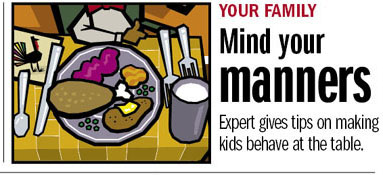|

Tabled Manners
An etiquette expert says the decline of the
family dinner means kids are no longer learning to eat
properly
by Pam Adams of the Journal Star
Nov 24, 2008
Oh, how table
manners have evolved since the invention of the fork.
"They would rather touch their mouths with their little
forked instruments than with their fingers," a 15th
century English author wrote sarcastically of a French
king and his companions.
Many a modern-day mom moans for opposite reasons. The
kids can download, upload, text and program, but they
may as well eat with a trowel, the way they shovel food
into their mouths. They don't know the proper way to use
a fork, a knife or a napkin. They don't know table
manners at all.
And why should they?
Local etiquette expert Robin Thompson, like many manners
mavens before her, traces the decline of table manners
to the decline of family dinners.
"How often do people sit down to evening meals with
plates, silverware, napkins and no television?" she
asks.
"That evening meal teaches so much more in one hour than
we imagine - cooking, social skills, responsibility,
etiquette. That's why people don't know their manners;
they've never learned them."
Suddenly, the holidays roll around, several generations
gather at the in-laws for a sit-down supper, and the
lack of proper manners is on full display. It's as if
the children are inadvertently divulging a family secret
about what does, or does not, happen at home. Great-aunt
Sally's raised eyebrows signal a tsk-tsk in Mother's
direction.
The rituals of dinner
But getting the entire family to use proper manners is
not an impossible task. Thompson does etiquette seminars
for individuals and groups ranging from high school
students to corporations. "People want the poise," she
says, "they want to know the dining etiquette and social
skills."
It might help to know Europe and the United States took
eight centuries to fully accept the fork as a
replacement for eating with fingers or from a knife
blade. In her 1991 book, "The Rituals of Dinner,"
Margaret Visser explores, as the subtitle says, the
origins, evolution, eccentricities and meaning of table
manners - including the rise of the fork.
"Table manners," she writes, "are social agreements.
They are devised because violence could so easily erupt
at dinner ... and the implements required for it could
quickly become weapons."
Speaking of holiday gatherings, Thompson says
conversational skills are as much a part of etiquette as
dining skills. (See sidebar.) Whether eating or talking,
whether dinner is formal or informal, the point of table
manners is not to offend others at the table.
Obviously, that means: no burping, belching, stuffing
food into your mouth, chewing with your mouth open or
talking with your mouth full. No grabbing for serving
dishes, always passing to the right, always saying
"please" and "thank you."
Those are among the cardinal rules Thompson says apply
even to the most casual dining affairs. Other rules,
such as which fork to use when, are not meant to
humiliate the uninitiated. The basic guideline is simple
- use flatware in the order it is placed from outside to
inside. For example, if salad is served first, the salad
fork would be the one farthest from the plate.
"Think of how delicately and gently a surgeon uses a
scalpel," Thompson says. "That's how you should use
flatware. Don't stab and saw; everything should be
discreet."
Children learn by watching adults, including fathers,
she says.
Typically, mothers have better table manners than
fathers, which means mothers usually end up doing the
training.
"That's not right; it should be equal. Poor Mom, Dad
should give her a break."

Home
| Etiquette Book
| Children/Teens | Corporate/College
Class Locations
| Press Coverage
| Graduation Photos | Contact | Links
|



